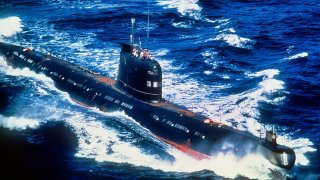Foxtrot-Class: The Old Russian Submarine with a Notorious Past
The Foxtrot-class may no longer be in service, but the Soviet submarines will always be remembered for the critical role it played during the Cuban Missile Crisis.
Summary: This article discusses the historical significance of the Soviet Foxtrot-class submarines during the Cold War. One notable incident occurred in 1962 during the Cuban Missile Crisis when a Foxtrot-class submarine almost launched a nuclear torpedo against U.S. forces. The Foxtrot-class, designed to address the shortcomings of its predecessor, played a critical role in the Soviet Navy, with specifications including displacement, size, and armament details. Despite technological obsolescence by the 1970s, Foxtrot submarines remained formidable and was exported around the world.
Foxtrot-class submarines of the Cold War:
During the Cold War, one Soviet-designed submarine perhaps gained the most notoriety. In October 1962, four USSR Foxtrot-class diesel subs armed with nuclear weapons were deployed as part of the USSR’s massive Cuba strategy. Unbeknownst to the U.S. at the time, the B-59 Foxtrot nearly launched a nuclear torpedo against American anti-submarine warfare forces.
The Captain of the Soviet vessel mistakenly believed they were under attack. Eventually, the Captain learned that American ships were actually signaling, not attacking, the SSN and backed down. However, it was truly a close call. It was at this moment, when Washington and Moscow came concerningly close to all-out nuclear war, when the Foxtrot-class rose to global prominence.
Introducing the Foxtrot-class submarines:
As the former Soviet Union’s most successful post-Second World War diesel-electric attack submarine, the Foxtrot-class played a critical role in the Soviet’s Navy. These vessels were designed to replace the USSR’s aging Project 611 submarines, which were designated as the Zulu class by the North Atlantic Treaty Organization (NATO).
The Zulu ships had capabilities similar to the American GUPPY fleet-boat conversions. In the late 1950’s, six Zulu submarines were converted and became the first ballistic missile vessels ever to enter service across the globe.
One was armed with a single R-11FM Scud missile while five other ships in this family were equipped with two Scuds each. Perhaps the Zulu-class’ most recognizable trait is that it served as the basis for the Foxtrots.
Project 641 (NATO codename “Foxtrot”) was developed with the Zulu shortcomings in mind. Specifically, Soviet officials wanted to rectify the perceived lack of strength of these vessels. Each Foxtrot displaced 2,000 tons when surfaced and more than 2,500 tons when submerged. The ships measured 295 feet and were powered by three Kolomna 2D42M diesel units of 2,000 horsepower output, three Electric motors with two generating roughly 1,300 horsepower, with the third outing about 2,700 horsepower.
The first Foxtrot-class keel was laid down in 1957 and commissioned one year later. The last submarine in this class was completed in the early 1980’s. Each boat was built for the Soviet Navy at the Sudomekh division of the Admiralty Shipyard (currently Admiralty Wharves), Saint Petersburg.
Foxtrot-Class: Specs & Capabilities
While the Foxtrot was larger in size than its Zulu predecessors, each ship in this class had 2 of its 3 decks dedicated to batteries. This enabled underwater endurance for up to 10 days, which stymied the submarines’ speed. The Foxtrot could only travel at an average rate of 2 knots at its maximum submerged time capability.
By the time the last Foxtrot models were laid down in the early 1970s, the submarine family was deemed technologically obsolete. One of the last active service Project 641 vessels- the Zaporizhia- was captured by Russian forces during the 2014 annexation of Crimea. Notably, when the submarine was seized, the Black Fleet did not want the Cold War sub. Instead, the Russian military offered to return the submarine back to Ukraine.
In terms of armament, the Project 641 submarines were quite formidable. The family of ships in total carried twenty-two torpedoes. During the Cold War, the Foxtrot class was a regular component of all four Soviet Navy fleets. In the late 1960’s, India became the first foreign client of this submarine series.
Eight new-build ships were delivered to the Indian Navy and were later renamed as the Kalvari-class. Libya would follow suit a few years later, procuring six boats between the late 1970’s and early 1980’s. Around this time, Poland also received a pair of these ships which they operated until 2003.
How the Foxtrot-Class Rose to Global Prominence
During the height of the Cold War, several Foxtrot submarines were sent to Cuba from their base on the Kola peninsula to patrol the Caribbean. In one incident, U.S. Navy destroyers dropped practice depth charges near these Soviet submarines to force them to surface and be identified. While three of the four Foxtrots were forced to surface, one was able to evade U.S. detection. Since B-59 was too deep to establish radio contact, the ship believed war had broken out between Moscow and Washington.
Both the captain and political officer onboard the submarine firmly believed that the signaling charges were actual depth charges and that the vessel was under attack. This line of thinking forced both individuals to strongly advocate for arming and firing the nuclear-tipped torpedo onboard. Miraculously, the flotilla admiral Vasily Arkhipov was on B-59 and refused to give his consent to launch the nuclear weapon. By overruling the two other officers on board, Akhipov can be commended for single-handedly preventing the outbreak of nuclear war at this time.
The Foxtrot-class may no longer be in service, but the Soviet submarines will always be remembered for the critical role it played during the Cuban Missile Crisis.
About the Author: Maya Carlin
Maya Carlin, National Security Writer with The National Interest, is an analyst with the Center for Security Policy and a former Anna Sobol Levy Fellow at IDC Herzliya in Israel. She has by-lines in many publications, including The National Interest, Jerusalem Post, and Times of Israel. You can follow her on Twitter: @MayaCarlin. Email the Author: [email protected].


